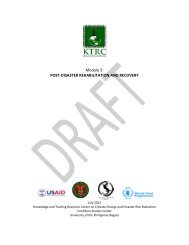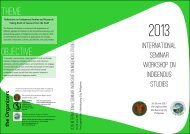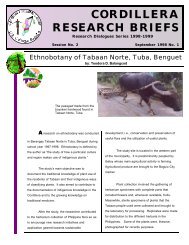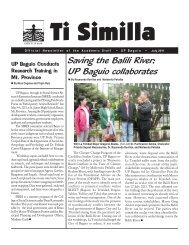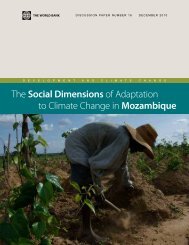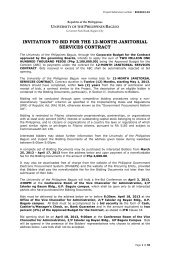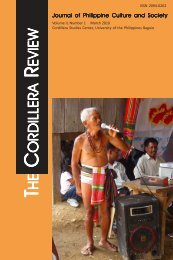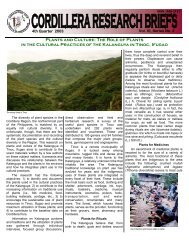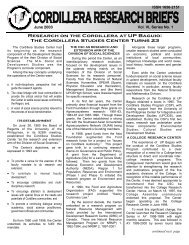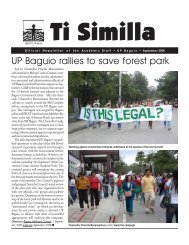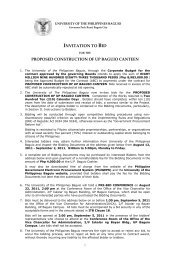Pambansang Summit sa W ambansang Summit sa W ... - UP Baguio
Pambansang Summit sa W ambansang Summit sa W ... - UP Baguio
Pambansang Summit sa W ambansang Summit sa W ... - UP Baguio
You also want an ePaper? Increase the reach of your titles
YUMPU automatically turns print PDFs into web optimized ePapers that Google loves.
Lecture<br />
Colonialism and Gender<br />
A Report on American Colonization and Gender Relations<br />
in Central Cordillera (1900-1941)<br />
By Sabrina Nikki Ramos<br />
Within the social sciences, there is now a<br />
growing critical inquiry into the notion of<br />
diffusionism: the idea that development can<br />
only take place when there is exposure to an<br />
outside group. Accordingly, if left alone, ‘primitive’<br />
or ‘elementary’ forms of life would remain<br />
the <strong>sa</strong>me and improvement would be<br />
painstakingly slow. This in turn necessitates<br />
the apparent need to open one’s doors (or culture)<br />
to outside influence (usually in the form<br />
of colonial knowledge and influence).<br />
However, what this idea takes for<br />
granted is that not all influences from<br />
outside are neces<strong>sa</strong>rily good and<br />
would contribute to improvement.<br />
One should be careful however not<br />
to draw an equally erroneous conclusion<br />
that cultures are ‘pure’ and<br />
consist of a homogenous and unified<br />
system of ideas and values that if tampered<br />
with, would result in its demise.<br />
Rather, what is neces<strong>sa</strong>ry is a<br />
grounded and fair analysis of how cultures<br />
mediate outside influences such<br />
that agency and power relations are<br />
not taken for granted nor complacently<br />
evaded.<br />
Many are of the view that gender relations<br />
in the Cordillera are for the most part egalitarian<br />
and that the current power formations that<br />
we see at play in terms of gender could be traced<br />
back to ‘influence’ from outside, more specifically<br />
colonial influence from the Americans.<br />
The question then that we are faced with is<br />
this, are we correct to interpret gender relations<br />
in Cordillera in this light? This is precisely<br />
what Dr. Raymundo Rovillos, the Dean<br />
of the College of the Social Sciences attempted<br />
to address last February 18, 2011 when he delivered<br />
a talk that inquired into the effects of<br />
American colonialism on gender relations in<br />
the Central Cordillera. Employing archival<br />
research as a method, the study explored the<br />
role of education and mission in influencing<br />
gender relations in terms of gender ideology,<br />
gender division of labor and sexuality, com-<br />
paring gender practices prior to and during the<br />
colonial regime.<br />
It was observed that from 1900-1905, the<br />
gender division of labor in Ifugao was supposedly<br />
based on the capabilities that were deemed<br />
‘natural’ to men and women. Thus, men were<br />
given the hardest work such as rice field construction,<br />
blacksmithing and wood gathering.<br />
Women on the other hand were in charge of<br />
basket weaving, planting rice and caring for<br />
the growing rice. Interestingly, one can see that<br />
even if the women were given relatively lighter<br />
load, they in fact did most of the work as can<br />
be seen in the division of labor when it comes<br />
to rice farming. It is worth noting however,<br />
that there were some tasks that both men and<br />
women contributed to such as spading fields,<br />
harvesting, carrying rice, cooking and child caring/rearing.<br />
This then indicates that in terms of gender<br />
ideology it is noticeable that indigenous culture<br />
is one in which women have always had a<br />
measure of equality with men. This is especially<br />
true as can be seen from the examples<br />
above as both men and women contributed to<br />
work outside and inside the home. Since it<br />
was the men who did the difficult work, it was<br />
but fair that women compen<strong>sa</strong>te in doing more<br />
work than them. Thus, there seems to be an<br />
equal recognition of the importance of both<br />
Missionary teaching reified<br />
gender stereotypes<br />
men and women’s contribution. Women’s<br />
sexuality however can be seen to be inextricably<br />
related to their role as child-bearers, for<br />
the reproduction of the clan/kinship. In the<br />
<strong>sa</strong>me way that they were in charge of caring<br />
for children, they were also tasked with caring<br />
for and planting rice, thus exhibiting their ‘natural’<br />
affinity with nurturing tasks.<br />
However, with the onset of the colonial<br />
regime from 1905 to 1941, there were stark<br />
differences that took place. In line<br />
with the framework of benevolent<br />
assimilation, the colonial regime<br />
gave particular importance to educating<br />
the Igorots. It was imperative<br />
that the culture and customs of<br />
the Igorots be studied with great care<br />
in order to facilitate better governance.<br />
Moreover, the general thrust<br />
of education can be characterized to<br />
be a simple form of industrial training,<br />
equivalent to what we now<br />
know as vocational courses. Igorots<br />
can be educated to be better carpenters,<br />
better gardeners and farmers:<br />
they can be the best that they can<br />
in the realm of manual labor, but they should<br />
not traverse this sphere as doing so would entail<br />
departing widely from their habitual course<br />
of life. Of course one should not forget that<br />
knowledge of a cultivated (colonial) language<br />
is also neces<strong>sa</strong>ry “to enable them to deal advantageously<br />
with the civilized inhabitants by<br />
whom they are surrounded.”<br />
All of this implies that the colonial regime<br />
looked at the Igorot people as incapable of<br />
development when left alone in their natural<br />
surroundings. The <strong>sa</strong>me is true even with Christian<br />
missions as these served as an effective colonial<br />
instrument.<br />
As can be seen in the quote above, the<br />
Igorot people were seen to have a potential for<br />
development, but great care was <strong>sa</strong>id to be<br />
exercised in identifying those who have superior<br />
intelligence and capacity for leadership.<br />
continued on page 12<br />
April 2011 TI SIMILLA 7





